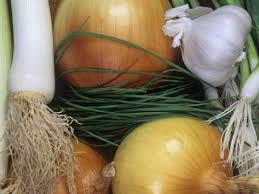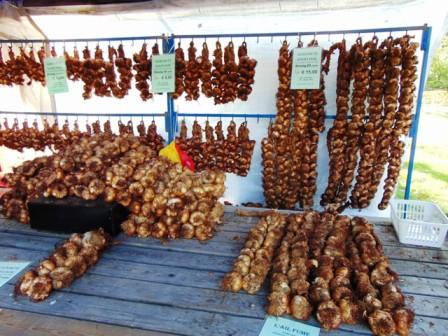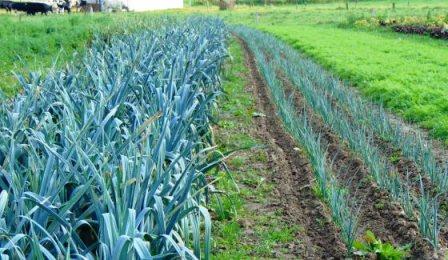Onion -like: allium or the garlic family contains about 600 species, Alliaceae. They are perennial bulbous plants, spicy and with a strong onion smell. They have narrow leaves, mostly with parallel veins and are real taste makers.
 In ancient Rome, the onion (Allium cepa L.) was called 'unio', single onion, as distinct from the garlic, which is a sphere divided into multiple cloves, and shallots, that grow different spheres in a group against each other. The word is still recognizable in English (onion) and French (oignons). Flemings took the plural form ui - jen for their ajuin.
In ancient Rome, the onion (Allium cepa L.) was called 'unio', single onion, as distinct from the garlic, which is a sphere divided into multiple cloves, and shallots, that grow different spheres in a group against each other. The word is still recognizable in English (onion) and French (oignons). Flemings took the plural form ui - jen for their ajuin.
A bulbil is a stem bulb that can be eaten or planted. Bulbils may occur with chives, shallots, and garlic. A planted garlic bulbil produces in the first year a small sphere, the second year a composite sphere.
This form of vegetative propagation is called false viviparie or viviparous: the phenomenon that offspring of a living creature comes directly from the parent organism.
An onion (Allium cepa) is a bulb of together sitting, thickened fleshy leaves. The thinner outer layers are dried tunics. In the heart are strains (apex) from which new plants can grow. Onions are in white, yellow and red, and soft to spicy.
The onions are sown in the spring between 1 March and mid-April.
You can harvest onion in the summer and store until spring to plant in March, or harvest later for consumption.
If the leaves are still attached they are called green onions. Onions are sometimes sold by the bunch.
If all leaves are withered then they are storage onions. Onions are harvested when the stems snaps. Pull them out of the ground and leave them on the spot to dry. Or hang them in bunches or plaited in a cool place.
Silver Onions are small white onions pickled in vinegar. They should be seeded deep (about 5 centimeters), in order to avoid that they become green (by light).
Tearing eyes by onion
When onion cells break down sulfuric compounds are formed. This frees gas (syn-propanethial-S-oxide). This forms, in contact with the vitreous humor (eye wet), a sulfuric acid compound which irritate the nerve endings in the eye. This can cause eye watering. It has the same effect as with tear gas.
The tears would be prevented by peeling onions under water or keep knife and cutting board wet with cold water.
If you got flu or a stuffy nose you can put a half onion on the bedside table, drink onions tea or eat raw onion. The nose remains open.
Of onion and shallot you can also use the green, hollow sheet or tube tops.
The word shallot (Allium ascalonicum) is derived from the name of a city in ancient Palestine: Ascalion. The balls are with four and more together. Those you can eat or transplant. You put them up to the neck in loosened soil.
There are red and yellow shallots. Some users find shallot sweeter or more “sophisticated" than onion.
 Garlic (Allium sativum L) was called by the Romans 'Allium'. A sphere is made up of several cloves, usually white, but possibly ranging up to red.
Garlic (Allium sativum L) was called by the Romans 'Allium'. A sphere is made up of several cloves, usually white, but possibly ranging up to red.
Plant the cloves about 5 cm deep preferably in October, November, because the crop must overwinter. For a good development, garlic needs two months of cold period. Therefore provide planting in the autumn the best yield. It is dependent on the species. A larger toe delivers a larger plant and a larger sphere. A large sphere consists of six to eight toes.
If the leaf turns yellow garlic can be harvested. Do not wait as long as with onion because sprouting may occur, which makes the toes shoot and grow again.
Garlic (especially fresh) is toxic to dogs and (especially) cats.
It would have natural antiseptic and antibacterial properties. Besides, it also works against evil spirits, witches, vampires and the devil.
It is good at anything and everything, cancer, bacteria, heart weakness, fungi...
In <Nasty smells> you find information about garlic breath and smell.
Chives (Allium schoenoprasum) is a hardy perennial that still exists in the wild.
You may regularly cut off the leaf stems, the plant is growing again.
Both the leaves and the flowers are used fresh and raw.
You can sow or tear to propagate.
In bear’s (or wild) garlic (Allium ursinum) bear would refer to the deciduous forests where both the animals and the garlic occurred. He has a garlic-like smell and taste.
 Leek (Allium (ampeloprasum var.) porrum) is a major fall- and winter vegetable. By using different varieties there are year round leeks. There are major differences in hardiness. After the winter, leeks begin to re- grow considerably.
Leek (Allium (ampeloprasum var.) porrum) is a major fall- and winter vegetable. By using different varieties there are year round leeks. There are major differences in hardiness. After the winter, leeks begin to re- grow considerably.
Under the influence of cold in winter, leeks is generative and is going late April - early May at the expense of the leaves to form a stem (bolting) and prosper.
If the plants have the thickness of a pencil, they are transplanted. Shortening leaves or roots makes little sense and does not give more revenue. It looks more standardized and clean, and it plants easier. But you may also make the hole a little wider and deeper, and hurt the plant as little. Also do not mind if you got some double- seated roots. You can reduce this putting the plant twisting into the hole. Place the leaves fluttering in the direction of the plant line, so you can still easily hoeing between the rows and ridging.
To get a long white shaft the plants are put 20 cm deep. Later, the plants can be even more earthed up. As long as there is no light the bleached part remains white.
The green part is the same leaf, and just as edible. The bleached white part is and tastes softer. (The roots are moreover also perfectly edible.)
Wild leek, see <Perennial in the garden>
